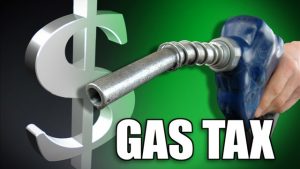Get ready for another gas tax increase
By | Follow on Twitter
Drivers in Pennsylvania face the third and last installment of gas tax increases Jan. 1 resulting from Act 89, a bipartisan effort to address a large backlog of highway and bridge repair needs in the state.
The increase in the tax is the equivalent of about eight cents per gallon, which is expected to generate $299 million more next year to fix roads and bridges and pay for state police protection on the highways.
"It's crucial for the economy of the state and the local economy as well. The reason it is so important is Pennsylvania has a very large and old network of roads and bridges," said Rich Kirkpatrick, spokesman for Pennsylvania Department of Transportation.
By 2018, Act 89 will have provided $2.4 billion more for roads and bridges in total. Contracts for improvements and repairs have increased from $1.5 billion to $2.4-2.5 billion this year, Kirkpatrick said.
Of the additional $299 million next year, $267 million will go to state highway and bridge projects and $32 million for local highway and bridge improvements.
The current tax is about 50 cents per gallon, which will rise to about 58 cents in January. A federal excise tax adds another 18.4 cents, bringing the tax total to 76.4 cents.
Kirkpatrick said it's hard to predict how much of the additional gas tax will be passed on to consumers.
But Patrick DeHaan, senior petroleum analyst for GasBuddy, predicts "Almost immediately gas prices will go up overnight."
"Drivers will see an eight-cent jump. Gas stations don't have enough margin to digest any increase in tax other than maybe a penny or two. It's always passed onto the consumer," DeHaan said.
There shouldn't be a significant impact on business from the gas tax increase, said Dave Black, president and CEO of the Harrisburg Regional Chamber and CREDC.
He said eight cents is a little more than a 3 percent increase over prices now, and just a little over the Consumer Price Index. Four or five years ago, gas prices were $3 a gallon, he noted.
"I don't like paying more for gas, but at least with this I know where it's going, what it is being used for, plus it is not only improving our highways, but it is putting a lot of people to work in the construction industry. Short term pain, long term gain as the saying goes," Black said.
How Pennsylvania compares
Pennsylvania already ranks top in the nation in gas taxes, compared to the average of 48.86 cents, according to GasBuddy.
But it's unfair to compare Pennsylvania's gas tax with other states, Kirkpatrick said, since other states have various means of paying for roads and bridges instead of relying mainly on gas taxes and motor license fees.
Some charge sales tax, and some have vehicle registration fees in the hundreds of dollars, Kirkpatrick said.
And Pennsylvania's road system is larger than many states. It is equal to that of New England, New Jersey and New York combined, he said.
"It is a user fee in essence. If you are driving and buying gas, you are being charged a user fee to keep the roads in good shape," Kirkpatrick said.
Without the additional revenue, we would face deteriorated highways and bridges, more vehicle repairs, and weight restrictions or closures on roads and bridges, Kirkpatrick said.
The state's Act 89 web site shows 9,557 projects totaling about $32 billion are planned or completed over the next 12 years, provided funding is available.
The contracts also mean jobs for contractors, with 75 percent of the work done by the private sector, he added.
"It's a huge economic engine for the state," he said. Every billion invested in transportation equals 25,000 good-paying private sector jobs.
GasBuddy expects Pennsylvania to continues in its position as having the highest gas taxes in the nation, DeHaan said.
Many states adjust their taxes every six months based on wholesale prices, he said, changing a penny or two. But he said he isn't aware of anyone raising taxes to the extent they would pass Pennsylvania.
Here's how the gas tax has changed
Under Act 89, in January 2014 the gas tax went from 31 to 40 cents per gallon, and in 2015 it rose from 40 to 50 cents.
It is a percentage tax imposed at the wholesale level.
Prior to Act 89 there was a $1.25 cap on the base fuel price that was taxed, even though the wholesale price was much higher, Kirkpatrick said.
Act 89 removed the cap, raising the base price in stages to increase funding.
In January the base will increase to $2.99.
The gas tax is in the form of mills (one-thousandth of a cent), which is multiplied by the base.
The new gas tax millage in January will be 194.5, compared to the current 201.5.
To calculate the new gas tax, you multiple 2.99 by 0.1945, which yields 58 cents.
Here are some other road/bridge repair facts:
- Under Act 89, the state reduced the number of structurally deficient bridges from 6,034 in 2008 to 3,600 in 2015.
- The average age of bridges is 50 years.
- Rebuilding a mile of interstate costs $5 million.
- Pennsylvania has 40,000 miles of state roads and 25,000 bridges. It is the fifth largest road system in the U.S., and the third largest number of bridges.
- Pennsylvania also gets $1.6 billion in federal highway funding each year. But the bulk of road funding comes from motor license funds and gas tax, which can only be used on roads, bridges and for state police protection on highways, Kirkpatrick said.
Outlook for gas prices
Gas prices will be higher in 2017, as production is cut by OPEC and non-OPEC nations. "It will tilt back into a balancing market where supply and demand are closer to each other. In the past supply exceeded demand," DeHaan said.
He estimates prices will rise to the $2.65 range for the 2017 national average.
That will cost motorists an average of about $150 more next year.
Story from PennLive.com



